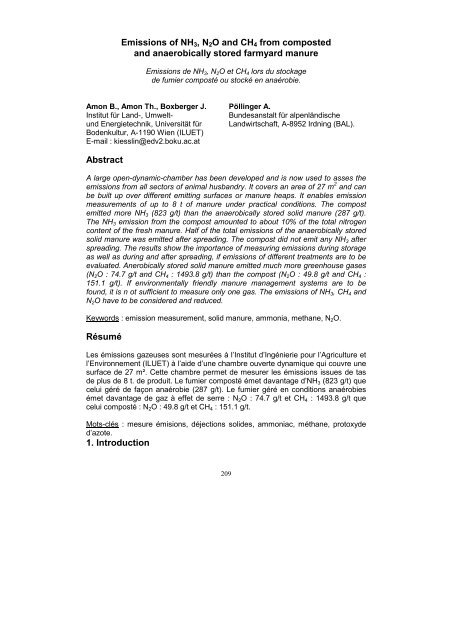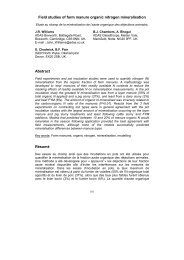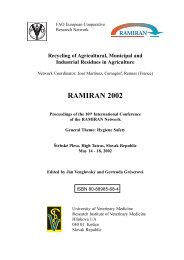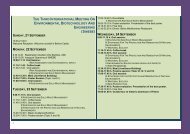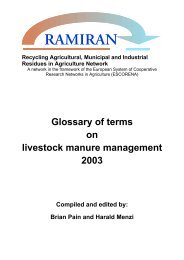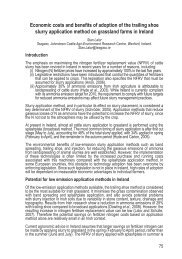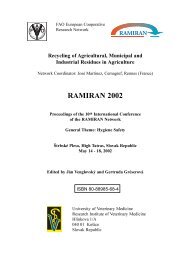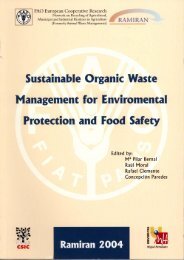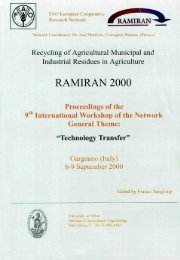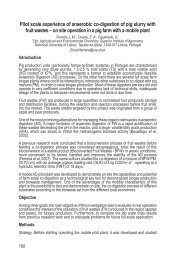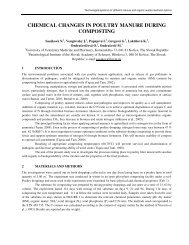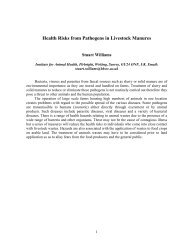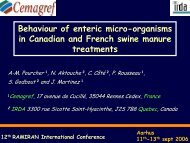Emissions of NH3, N2O and CH4 from composted and ... - Ramiran
Emissions of NH3, N2O and CH4 from composted and ... - Ramiran
Emissions of NH3, N2O and CH4 from composted and ... - Ramiran
Create successful ePaper yourself
Turn your PDF publications into a flip-book with our unique Google optimized e-Paper software.
<strong>Emissions</strong> <strong>of</strong> NH 3 , N 2 O <strong>and</strong> CH 4 <strong>from</strong> <strong>composted</strong><br />
<strong>and</strong> anaerobically stored farmyard manure<br />
<strong>Emissions</strong> de NH 3 , N 2 O et CH 4 lors du stockage<br />
de fumier composté ou stocké en anaérobie.<br />
Amon B., Amon Th., Boxberger J.<br />
Institut für L<strong>and</strong>-, Umweltund<br />
Energietechnik, Universität für<br />
Bodenkultur, A-1190 Wien (ILUET)<br />
E-mail : kiesslin@edv2.boku.ac.at<br />
Pöllinger A.<br />
Bundesanstalt für alpenländische<br />
L<strong>and</strong>wirtschaft, A-8952 Irdning (BAL).<br />
Abstract<br />
A large open-dynamic-chamber has been developed <strong>and</strong> is now used to asses the<br />
emissions <strong>from</strong> all sectors <strong>of</strong> animal husb<strong>and</strong>ry. It covers an area <strong>of</strong> 27 m 2 <strong>and</strong> can<br />
be built up over different emitting surfaces or manure heaps. It enables emission<br />
measurements <strong>of</strong> up to 8 t <strong>of</strong> manure under practical conditions. The compost<br />
emitted more NH 3 (823 g/t) than the anaerobically stored solid manure (287 g/t).<br />
The NH 3 emission <strong>from</strong> the compost amounted to about 10% <strong>of</strong> the total nitrogen<br />
content <strong>of</strong> the fresh manure. Half <strong>of</strong> the total emissions <strong>of</strong> the anaerobically stored<br />
solid manure was emitted after spreading. The compost did not emit any NH 3 after<br />
spreading. The results show the importance <strong>of</strong> measuring emissions during storage<br />
as well as during <strong>and</strong> after spreading, if emissions <strong>of</strong> different treatments are to be<br />
evaluated. Anerobically stored solid manure emitted much more greenhouse gases<br />
(N 2 O : 74.7 g/t <strong>and</strong> CH 4 : 1493.8 g/t) than the compost (N 2 O : 49.8 g/t <strong>and</strong> CH 4 :<br />
151.1 g/t). If environmentally friendly manure management systems are to be<br />
found, it is n ot sufficient to measure only one gas. The emissions <strong>of</strong> NH 3 , CH 4 <strong>and</strong><br />
N 2 O have to be considered <strong>and</strong> reduced.<br />
Keywords : emission measurement, solid manure, ammonia, methane, N 2 O.<br />
Résumé<br />
Les émissions gazeuses sont mesurées à l’Institut d’Ingénierie pour l’Agriculture et<br />
l’Environnement (ILUET) à l’aide d’une chambre ouverte dynamique qui couvre une<br />
surface de 27 m². Cette chambre permet de mesurer les émissions issues de tas<br />
de plus de 8 t. de produit. Le fumier composté émet davantage d’NH 3 (823 g/t) que<br />
celui géré de façon anaérobie (287 g/t). Le fumier géré en conditions anaérobies<br />
émet davantage de gaz à effet de serre : N 2 O : 74.7 g/t et CH 4 : 1493.8 g/t que<br />
celui composté : N 2 O : 49.8 g/t et CH 4 : 151.1 g/t.<br />
Mots-clés : mesure émisions, déjections solides, ammoniac, méthane, protoxyde<br />
d’azote.<br />
1. Introduction<br />
209
Farmyard manure can either be anaerobically stored or aerobically <strong>composted</strong>.<br />
Most <strong>of</strong> the investigations that have been carried out so far concentrated on<br />
ammonia emissions <strong>from</strong> <strong>composted</strong> FYM (DEWES 1996, RÖMER ET AL. 1994).<br />
Recently also N 2 O <strong>and</strong> CH 4 emissions have been included in the measurements on<br />
the laboratory scale (e.g. HÜTHER ET AL. 1997, OSADA ET AL. 1997). Emission<br />
measurements should be carried out under field conditions <strong>and</strong> should include all<br />
ecologically harmful gases. As the way <strong>of</strong> storing farmyard manure influences the<br />
change <strong>of</strong> manure composition (esp. NH 4 content) <strong>and</strong> as the composition <strong>of</strong> the<br />
farmyard manure influences the amount <strong>of</strong> ammonia emissions after spreading<br />
(MENZI ET AL. 1997), the emissions during storage <strong>and</strong> after spreading <strong>of</strong> the<br />
manure should be included in the investigations.<br />
2. Experimental<br />
If the emission rate is to be determined, gas concentration <strong>and</strong> air flow have to be<br />
known. Concentrations <strong>of</strong> NH 3 , N 2 O <strong>and</strong> CH 4 are analysed by a high resolution<br />
FTIR spectroscope. For the determination <strong>of</strong> the air flow over manure storages <strong>and</strong><br />
during <strong>and</strong> after spreading <strong>of</strong> manure the ILUET has developed a large opendynamic-chamber<br />
(AMON ET AL. 1997). It is described in ”<strong>Emissions</strong> <strong>of</strong> NH 3 , N 2 O<br />
<strong>and</strong> CH 4 <strong>from</strong> a tying stall for milking cows, during storage <strong>of</strong> solid manure <strong>and</strong><br />
after spreading” in these proceedings.<br />
The ILUET compared emissions <strong>from</strong> anaerobically stored <strong>and</strong> aerobically<br />
<strong>composted</strong> FYM <strong>from</strong> a tying stall for milking cows under summer <strong>and</strong> under winter<br />
conditions. The summer period lasted <strong>from</strong> June to September 1996, the winter<br />
period <strong>from</strong> march to June 1997. Two heaps <strong>of</strong> farmyard manure were stored on<br />
concrete slabs with a drainage system. Seepage water emissions during storage<br />
were collected <strong>and</strong> analysed for their N content. The temperature in the two heaps<br />
was measured continuously at six places in each heap. Table 1 shows the<br />
composition <strong>of</strong> the <strong>composted</strong> <strong>and</strong> the anaerobically stored FYM <strong>and</strong> the mean<br />
temperature inside the manure heaps. The large open-dynamic-chamber was<br />
moved <strong>from</strong> one heap to the other three times a week to measure the emissions. In<br />
the summer trial each manure heap consisted <strong>of</strong> 3.5 t <strong>of</strong> farmyard manure. In the<br />
winter trial about 7t <strong>of</strong> farmyard manure were investigated.<br />
DM Nt NH4-N C/N pH temp.<br />
[\%] [kg/t] [kg/t] [°C]<br />
summer<br />
<strong>composted</strong> FYM (su) 28.3 6.60 1.10 14 7.55 45.0<br />
anaerobically stored FYM (su) 20.4 6.39 1.17 14 7.43 35.3<br />
winter<br />
210
<strong>composted</strong> FYM (wi) 22.1 6.69 0.63 16 8.70 34.3<br />
anaerobically stored FYM (wi) 21.2 6.31 0.43 15 8.20 22.4<br />
Table 1.<br />
Composition <strong>of</strong> the farmyard manure <strong>and</strong> mean temperature inside<br />
the manure heaps<br />
One heap was <strong>composted</strong> aerobically, which means it was turned seven times<br />
during the storage period. The turning was performed by h<strong>and</strong>. The large opendynamic-chamber<br />
was built up over the compost <strong>and</strong> collected the emissions<br />
during <strong>and</strong> after the turning. The other heap was stored anaerobically. No<br />
manipulations were performed during the storage period.<br />
After the storage period the large open-dynamic-chamber was built up on grassl<strong>and</strong><br />
<strong>and</strong> the <strong>composted</strong> <strong>and</strong> the anaerobically stored FYM were spread in the chamber.<br />
The amount <strong>of</strong> spreaded manure was equivalent to 20 t/ha. <strong>Emissions</strong> during <strong>and</strong><br />
after spreading were also measured so that the sum <strong>of</strong> emissions (storing, turning<br />
<strong>and</strong> spreading) could be determined. The spreading <strong>of</strong> the summer trial was<br />
performed in September 1996. The temperatures were low during the spreading <strong>of</strong><br />
the farmyard manure (10°C). The farmyard manure <strong>from</strong> the winter trial was spread<br />
at the beginning <strong>of</strong> June 1997 under warm conditions (20°C).<br />
3. Results<br />
3.1. <strong>Emissions</strong> during storage <strong>and</strong> after spreading or farmyard manure.<br />
Table 2 shows the ammonia emissions during storage <strong>and</strong> after spreading <strong>of</strong><br />
<strong>composted</strong> <strong>and</strong> anaerobically stored FYM <strong>from</strong> the summer <strong>and</strong> winter trials.<br />
Ammonia emissions after spreading are given in reference to the amount <strong>of</strong><br />
farmyard manure at the beginning <strong>of</strong> the storage period to make a comparison<br />
possible between the different trials <strong>and</strong> the different ways <strong>of</strong> ammonia losses.<br />
In both trials the compost emitted more NH 3 than the anaerobically stored FYM.<br />
However NH 3 emissions <strong>from</strong> the winter compost were much lower than <strong>from</strong> the<br />
summer compost. This was due to heavy snowfall at the beginning <strong>of</strong> the winter<br />
storage period. The snow fell on the warm heap, melted <strong>and</strong> drained into the<br />
compost. Thus the oxygen supply inside the heap was very low <strong>and</strong> the composting<br />
process did not proceed well. The low temperatures inside the winter compost<br />
(table 1) also show, that due to the high water content the composting was not<br />
optimal. At the end <strong>of</strong> the storage period the winter compost was not crumbly <strong>and</strong><br />
fragrant, but muddy <strong>and</strong> evil-smelling.<br />
NH 3-losses [g NH 3/t FM a ]<br />
Storage turning spreading Sum<br />
<strong>composted</strong> FYM (su) 643.3 27.2 --- 670.5<br />
anaerobically stored FYM (su) 162.7 --- 85.3 248.0<br />
<strong>composted</strong> FYM (wi) 302.6 --- --- 302.6<br />
anaerobically stored FYM (wi) 46.2 --- 197.3 243.5<br />
a FM = fresh matter<br />
Table 2.<br />
211
Ammonia losses during storage <strong>and</strong> after spreading <strong>of</strong> <strong>composted</strong><br />
<strong>and</strong> anaerobically stored farmyard manure<br />
After spreading <strong>of</strong> the compost no ammonia emissions were detectable. This<br />
corresponds well to the results <strong>of</strong> MENZI ET AL. (1997) who found a correlation<br />
between ammonia emissions <strong>and</strong> NH 4 -N content <strong>and</strong> lower ammonia emissions<br />
<strong>from</strong> strongly decomposed FYM than <strong>from</strong> fresh farmyard manure. The summer<br />
<strong>and</strong> the winter compost did not contain any NH 4 -N at the end <strong>of</strong> the storage period<br />
<strong>and</strong> therefore no NH 3 was emitted after spreading.<br />
A considerable part <strong>of</strong> the ammonia emissions <strong>from</strong> the anaerobically stored FYM<br />
did not occur during storage, but after spreading. In the summer trial about 35% <strong>of</strong><br />
the total NH 3 emissions emitted after spreading, in the winter trial this share<br />
amounted to 81%. The following explanations can be found for this phenomenon:<br />
The summer farmyard manure was spread in September under relatively cold<br />
weather conditions <strong>and</strong> at a very low wind speed. Both factors reduce ammonia<br />
losses after spreading. The winter farmyard manure had a high water content that<br />
led to low NH 3 emissions during storage. The spreading was done at the beginning<br />
<strong>of</strong> June under warm weather conditions <strong>and</strong> at a wind speed <strong>of</strong> about 0.4 m/s. The<br />
ammonia emissions <strong>from</strong> the summer trial corresponded to 2.8 kg NH 3 /ha, those<br />
<strong>from</strong> the winter trial to 5.74 kg NH 3 /ha. The first value is very low compared to<br />
emissions found by other authors due to the conditions explained before. The<br />
second value corresponds well with data <strong>from</strong> the literature. MENZI ET AL. (1997)<br />
found mean NH 3 emissions <strong>of</strong> 52% <strong>of</strong> the spreaded NH 4 -N. CHAMBERS ET AL.<br />
(1997) give NH 3 emissions after spreading <strong>of</strong> cattle FYM <strong>of</strong> 8.6 kg NH 3 /ha. This<br />
value is higher than that found in our investigations probably due to the higher<br />
application rate (30.6 t/ha).<br />
Table 3 shows the total N losses <strong>of</strong> <strong>composted</strong> <strong>and</strong> anaerobically stored FYM <strong>from</strong><br />
the summer <strong>and</strong> winter trials. The sum <strong>of</strong> N emissions results <strong>from</strong> gaseous NH 3<br />
<strong>and</strong> N 2 O emissions <strong>and</strong> <strong>from</strong> liquid N emissions in the seepage water (NO 3 , NH 4 ).<br />
The total N emissions <strong>of</strong> all trials showed no major differences <strong>and</strong> amounted to<br />
6.47-10.84% <strong>of</strong> the N content <strong>of</strong> the farmyard manure at the beginning <strong>of</strong> the<br />
storage period. However the distribution <strong>of</strong> the emissions to the investigated<br />
sources differed considerably. This shows the importance <strong>of</strong> measuring all sources<br />
<strong>of</strong> N emissions if the ecological impact <strong>of</strong> the treatments is to be evaluated.<br />
N losses [g N/t FM a ]<br />
NH 3-N N 2O-N N in sea- Sum % <strong>of</strong><br />
page water<br />
total N<br />
<strong>composted</strong> FYM (su) 552.2 23.9 141.5 717.6 10.84<br />
anaerobically stored FYM (su) 205.7 36.5 260.1 502.3 7.79<br />
Composted FYM (wi) 249.2 30.0 200.1 479.3 7.60<br />
Anaerobically stored FYM (wi) 201.3 55.6 181.9 438.8 6.47<br />
a FM = fresh matter<br />
Table 3.<br />
N losses during storage <strong>and</strong> after spreading <strong>of</strong> <strong>composted</strong><br />
212
<strong>and</strong> anaerobically stored farmyard manure<br />
7<br />
<strong>NH3</strong> emission [g/(t*h)]<br />
6<br />
5<br />
4<br />
3<br />
2<br />
<strong>composted</strong> FYM<br />
turning <strong>of</strong> compost<br />
anaerob. stored FYM<br />
1<br />
0<br />
0 10 20 30 40 50 60 70 80<br />
day <strong>of</strong> trial<br />
Figure 1.<br />
Course <strong>of</strong> NH 3 emissions <strong>from</strong> <strong>composted</strong> <strong>and</strong> anaerobically stored FYM (summer)<br />
NH 3 emitted mainly at the beginning <strong>of</strong> the storage period. Figure 1 shows the<br />
ammonia emissions <strong>from</strong> <strong>composted</strong> <strong>and</strong> anaerobically stored FYM (summer).<br />
<strong>Emissions</strong> were high at the beginning <strong>of</strong> the storage but decreased rapidly. This<br />
course <strong>of</strong> emissions was observed also <strong>from</strong> the winter trials, but NH 3 emissions<br />
stayed on a lower level than during the summer trials (table 2).<br />
The course <strong>of</strong> CH 4 emissions differed <strong>from</strong> the course <strong>of</strong> ammonia emissions (fig.<br />
2). CH 4 emissions <strong>from</strong> the anaerobically stored FYM kept on a high level<br />
throughout the whole storage period. The decrease <strong>of</strong> CH 4 emissions in course <strong>of</strong><br />
the storage period was slow <strong>and</strong> they were still detectable at the end <strong>of</strong> the trial.<br />
That means that if the anaerobically stored FYM had been stored for a longer time,<br />
the sum <strong>of</strong> emissions would have increased. CH 4 emissions <strong>from</strong> the compost were<br />
always low.<br />
213
3,0<br />
2,5<br />
<strong>composted</strong> FYM<br />
anaerob. stored FYM<br />
<strong>CH4</strong> emission [g/(t*h)]<br />
2,0<br />
1,5<br />
1,0<br />
0,5<br />
0,0<br />
0 10 20 30 40 50 60 70 80<br />
day <strong>of</strong> trial<br />
Figure 2.<br />
Course <strong>of</strong> CH 4 emissions <strong>from</strong> <strong>composted</strong> <strong>and</strong> anaerobically stored FYM (summer)<br />
As a part <strong>of</strong> the N emissions is lost via the seepage water, the seepage water<br />
should be collected. Most <strong>of</strong> the liquid N losses emitted at the beginning <strong>of</strong> the<br />
storage. Therefore farmyard manure should at least in the beginning be stored on<br />
concrete slabs with the possibility <strong>of</strong> collecting the seepage water. This would be an<br />
easy possibility to avoid a considerable part <strong>of</strong> the N losses during storage <strong>of</strong><br />
farmyard manure.<br />
In table 4 the sum <strong>of</strong> greenhouse gas emissions <strong>from</strong> <strong>composted</strong> <strong>and</strong> anaerobically<br />
stored solid manure are shown. To compare the global warming potential <strong>of</strong> the two<br />
treatments, N 2 O <strong>and</strong> CH 4 emissions are given in CO 2 equivalents, that means<br />
relative to the global warming potential <strong>of</strong> CO 2 (EK 1995).<br />
Greenhouse gas emissions [kg CO 2 equiv./t FM a ]<br />
N 2O emissions CH 4 emissions Sum<br />
<strong>composted</strong> FYM (su) 8.87 4.96 13.83<br />
anaerobically stored FYM (su) 13.65 47.85 61.49<br />
<strong>composted</strong> FYM (wi) 12.27 24.21 36.48<br />
anaerobically stored FYM (wi) 20.64 18.41 39.05<br />
a FM = fresh matter<br />
Table 4.<br />
Greenhouse gas emissions <strong>of</strong> <strong>composted</strong> <strong>and</strong> anaerobically<br />
stored farmyard manure<br />
214
3,0<br />
2,5<br />
anaerobically stored FYM (wi)<br />
anaerobically stored FYM (su)<br />
<strong>CH4</strong> emission [g/(t*h)]<br />
2,0<br />
1,5<br />
1,0<br />
0,5<br />
0,0<br />
0 5 10 15 20 25 30 35 40 45<br />
temperature inside heap [°C]<br />
Figure 3.<br />
Dependency <strong>of</strong> CH 4 emissions <strong>from</strong> anaerobically stored FYM (su <strong>and</strong> wi)<br />
on the temperature inside the manure heap<br />
Greenhouse gas emissions <strong>from</strong> the anaerobically stored FYM (su) were about 4.5<br />
times higher than <strong>from</strong> the <strong>composted</strong> FYM (su). Methane emissions contributed<br />
about 78% to the total emissions. Methane is formed under anaerobic, warm<br />
conditions when degradable C is available. Conditions in the anaerobically stored<br />
FYM favoured methane production. In summer <strong>and</strong> winter trial methane emissions<br />
<strong>from</strong> the anaerobically stored FYM were observed during the whole storage period<br />
<strong>and</strong> had not come to their end by the end <strong>of</strong> storage. They were strongly dependent<br />
on the temperature inside the manure heap (fig. 3). As the temperatures in the<br />
winter FYM rose only at the end <strong>of</strong> the storage, methane emissions were lower than<br />
<strong>from</strong> anaerobically stored FYM in summer. But they should have become much<br />
higher if the storage had continued longer.<br />
Due to the lack <strong>of</strong> oxygen supply in the winter compost, N 2 O <strong>and</strong> CH 4 emissions<br />
were higher than <strong>from</strong> the summer compost. A sufficient aeration is essential for a<br />
good composting process. Insufficient oxygen supply leads to formation <strong>of</strong><br />
greenhouse gases.<br />
4. References<br />
215
[1] AMON, B., AMON, TH., BOXBERGER, J., PÖLLINGER, A., 1999. <strong>Emissions</strong> <strong>of</strong> <strong>NH3</strong>,<br />
N 2 O <strong>and</strong> CH 4 <strong>from</strong> a tying stall for milking cows, during storage <strong>of</strong> farmyard manure<br />
<strong>and</strong> after spreading. In : <strong>Ramiran</strong> 98, Proceedings ot the 8th International<br />
Conference on Management Strategies for Organic Waste Use in Agriculture,<br />
Rennes, France, 26-29 may 1998, Martinez J., Maudet M.N. (eds), FAO-Cemagref<br />
Editions, 269-277.<br />
[2] AMON, B., AMON, TH., BOXBERGER, J., PÖLLINGER, A., ZAUSSINGER, A.<br />
Entwicklung einer Meßeinrichtung zur Erfassung umweltrelevanter Gasemissionen.<br />
Die Bodenkultur 47, 4 (1997), S. 247-253.<br />
[3] CHAMBERS, B.J., SMITH, K.A., VAN DER WEERDEN, T.J. Ammonia emissions<br />
following the l<strong>and</strong> spreading <strong>of</strong> solid manures. In Gaseous Nitrogen <strong>Emissions</strong> <strong>from</strong><br />
Grassl<strong>and</strong>s (Oxon, UK, 1997, Jarvis, S.C.,Pain, B.F., Hrsg., CAB International, S.<br />
275-280.<br />
[4] DEWES, T. Biotisch und abiotisch bedingte NH 3 -Emissionen während der<br />
Lagerung von Stallmist. Agribiological Research 49, 2-3 (August 1996), S. 203-210.<br />
[5] ENQUÊTE-KOMMISSION SCHUTZ DER ERDATMOSPHÄRE DES 12. DEUTSCHEN<br />
BUNDESTAGES, Hrsg. Mehr Zukunft für die Erde: Nachhaltige Energiepolitik für<br />
dauerhaften Klimaschutz (Bonn 1995), Deutscher Bundestag, Economica Verlag.<br />
Schlußbericht der Enquête.<br />
[6] HÜTHER, L., SCHUCHARDT, F., WILLKE, T. <strong>Emissions</strong> <strong>of</strong> ammonia <strong>and</strong><br />
greenhouse gases during storage <strong>and</strong> composting <strong>of</strong> animal manures. In Ammonia<br />
<strong>and</strong> Odour Control <strong>from</strong> Animal Production Facilities (1997), EurAgEng, Hrsg., S.<br />
327-334. International Symposium, 6.-10. October 1997, Vinkeloord, The<br />
Netherl<strong>and</strong>s.<br />
[7] MENZI, H., KATZ, P., FRICK, R., FAHRNI,M., KELLER, M. Ammonia emissions<br />
following the application <strong>of</strong> solid manure to grassl<strong>and</strong>. In Gaseous Nitrogen<br />
<strong>Emissions</strong> <strong>from</strong> Grassl<strong>and</strong>s (Oxon, UK, 1997, Jarvis, S.C.,Pain, B.F., Hrsg., CAB<br />
International, S. 265-274.<br />
[8] OSADA, T., KURODA, K., YONAGA, M. N 2 O, CH 4 <strong>and</strong> NH 3 emissions <strong>from</strong><br />
composting <strong>of</strong> swine waste. In Ammonia <strong>and</strong> Odour Control <strong>from</strong> Animal Production<br />
Facilities (1997), EurAgEng, Hrsg., S. 373-380. International Symposium, 6.-10.<br />
October 1997, Vinkeloord, The Netherl<strong>and</strong>s.<br />
[9] RÖMER, G., BOEKER, P., SCHULZE-LAMMERS, P. Ammoniakemissionen von<br />
Festmist. L<strong>and</strong>technik 49, 2 (1994), S. 72-73.<br />
216


